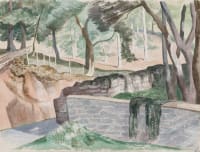We are grateful to Andrew Lambirth, author of John Nash: Artist and Countryman, for his kind assistance when writing this catalogue note.
Subtle and ethereal in atmosphere, the present work exemplifies John Nash’s deft understanding of the nuances of the British landscape.
Nash’s love of the authentic British countryside inspired his extensive travels throughout the British Isles. During the 1950s and 1960s, he spent time in North Wales between the historic counties of Merionethshire and Montgomeryshire, where this watercolour was painted. During a trip in the early 1950s, Nash described the landscapes of this area in a letter to artist Edward Bawden;
I have had great difficulty in getting used to this so entirely different scenery – I say “scenery” advisedly because these mountains do tend to look like postcard views & I find it difficult to tame them to a better state of order & design. Quite often one cannot see them at all creeping round their summits. They...
We are grateful to Andrew Lambirth, author of John Nash: Artist and Countryman, for his kind assistance when writing this catalogue note.
Subtle and ethereal in atmosphere, the present work exemplifies John Nash’s deft understanding of the nuances of the British landscape.
Nash’s love of the authentic British countryside inspired his extensive travels throughout the British Isles. During the 1950s and 1960s, he spent time in North Wales between the historic counties of Merionethshire and Montgomeryshire, where this watercolour was painted. During a trip in the early 1950s, Nash described the landscapes of this area in a letter to artist Edward Bawden;
I have had great difficulty in getting used to this so entirely different scenery – I say “scenery” advisedly because these mountains do tend to look like postcard views & I find it difficult to tame them to a better state of order & design. Quite often one cannot see them at all creeping round their summits. They are most impressive in dull weather or late in the evening…[1]
Nash met artists such as Bawden through his older brother, Paul Nash. It was on his brother’s advice that he didn’t receive any formal artistic education. Paul suggested that art school ruined one’s natural talent and that he was lucky to ‘begin free from the disadvantages of conventional training’. However, due to his brother’s training, he wasn’t oblivious to the teachings of prestigious art schools. Through Paul, he met numerous artists training at the Slade and Royal College of Art, who became incredibly influential throughout the development of his early career, such as Claughton Pellew, Dora Carrington, and Eric Ravilious.
This watercolour is characteristic of Nash’s preference for intimate landscapes. Nash often focused his attention on the foreground and middle ground of the composition, as evidenced in this enclosed view.
[1] Nash, J. quoted in Lambeth, A. (2019) Artist & Countryman. Norwich: Unicorn Press, p. 207.











